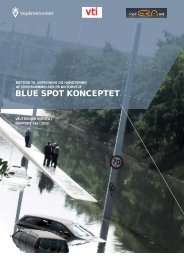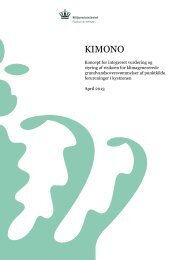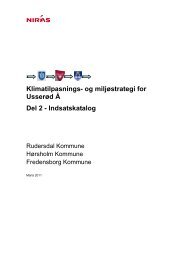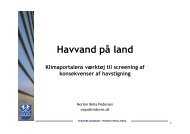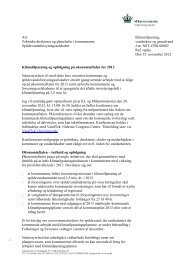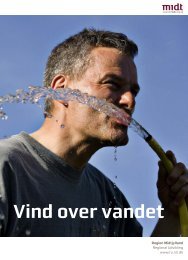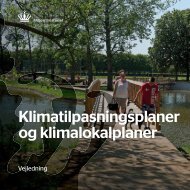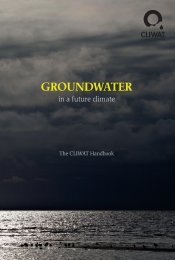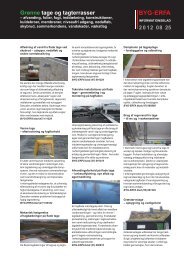Mapping climate change - barriers and opportunities for action
Mapping climate change - barriers and opportunities for action
Mapping climate change - barriers and opportunities for action
Create successful ePaper yourself
Turn your PDF publications into a flip-book with our unique Google optimized e-Paper software.
magnitudes. The Danish Road Directorate is working on managing <strong>climate</strong> <strong>change</strong> impacts on the<br />
basis of per<strong>for</strong>mance requirements. This involves preparing an <strong>action</strong> plan <strong>for</strong> <strong>climate</strong> <strong>change</strong><br />
adaptation on the basis of the Ministry of Transport's <strong>climate</strong> <strong>change</strong> adaptation strategy which<br />
contains targets <strong>and</strong> a milestone plan as well as a "declaration of services" concerning the<br />
availability of the transport infrastructure. The Danish Road Directorate is maintaining an ongoing<br />
dialogue with the municipalities on road regulatory work. The most recent knowledge, which the<br />
Danish Road Directorate has either developed itself or procured from external providers, will be<br />
included in this work <strong>and</strong> will there<strong>for</strong>e benefit the municipalities as well as the Directorate. The<br />
Directorate <strong>and</strong> the municipalities are also cooperating via SAMKOM, a cooperation <strong>for</strong>um <strong>for</strong><br />
public technical administrations, which involves benchmarking <strong>and</strong> knowledge-sharing activities.<br />
Rail Net Denmark is analysing road-related incidents, establishing warning systems <strong>and</strong> analysing<br />
the need to incorporate <strong>climate</strong> <strong>change</strong> adaptation in planning new rail installations. Furthermore,<br />
<strong>for</strong> the entire area under the Ministry of Transport, work is being carried out to manage <strong>climate</strong><br />
<strong>change</strong> impacts on the basis of per<strong>for</strong>mance requirements. This involves preparing an <strong>action</strong> plan<br />
<strong>for</strong> <strong>climate</strong> <strong>change</strong> adaptation on the basis of the Ministry of Transport's <strong>climate</strong> <strong>change</strong> adaptation<br />
strategy.<br />
Water<br />
For wastewater, regulations aimed at minimising the negative effects of flooding are being<br />
developed. As a general rule, the water utility companies can finance the necessary investments <strong>and</strong><br />
maintenance <strong>for</strong> the sewerage system via wastewater charges. It would be relevant to assess<br />
whether the water utility companies have the required tools <strong>and</strong> incentives to adapt to <strong>climate</strong><br />
<strong>change</strong> through e.g. investments in maintenance <strong>and</strong> expansion of the sewerage system. Amongst<br />
other things, this should be seen in light of the relationship between depreciation periods <strong>and</strong> loan<br />
repayment periods. Finally, it would be relevant to assess whether alternatives exist outside the area<br />
financed through charges to enhance the capacity <strong>for</strong> diverting surface <strong>and</strong> wastewater costeffectively,<br />
including letting private citizens manage the water on their own l<strong>and</strong>. The current rules<br />
on financing through charges provide only limited possibilities <strong>for</strong> financing such initiatives<br />
through wastewater treatment charges. This is to ensure that water consumers only pay <strong>for</strong> the costs<br />
that relate to wastewater management. At the same time, pursuant to the 2011 government<br />
programme, municipalities are obliged to prepare municipal <strong>climate</strong> <strong>change</strong> adaptation plans within<br />
two years.<br />
For groundwater, increased groundwater recharge will <strong>change</strong> the conditions <strong>for</strong> future water<br />
supply in the <strong>for</strong>m of increased groundwater resources <strong>and</strong> in the <strong>for</strong>m of e.g. increased<br />
groundwater recharge in the uppermost soil layers which leads to enhanced risk of groundwater<br />
flooding, <strong>and</strong> longer periods of drought which may require changing the catchment area. With<br />
regard to groundwater protection, ef<strong>for</strong>ts have been launched regarding protection zones around<br />
wells, <strong>and</strong> the need <strong>for</strong> <strong>climate</strong> <strong>change</strong> adaptation has also been incorporated in these ef<strong>for</strong>ts. A<br />
number of legislative acts <strong>and</strong> schemes contribute to protecting groundwater resources. In this area,<br />
there is a need to incorporate <strong>climate</strong> <strong>change</strong> adaptation as a consideration in public administration<br />
<strong>and</strong> in any amendments to the legislative basis. Existing groundwater models <strong>and</strong> other tools are<br />
deemed adequate to monitor the challenges arising from <strong>climate</strong> <strong>change</strong>, as long as data on the<br />
future <strong>climate</strong> are available.<br />
Agriculture<br />
Increases in temperature may lead to increases in productivity <strong>for</strong> agriculture if the adaptation of<br />
agriculture that is already ongoing continues. In this context it might be relevant to consider<br />
adjusting the regulations on the use of pesticides in agriculture, as the increases in temperature may<br />
8



